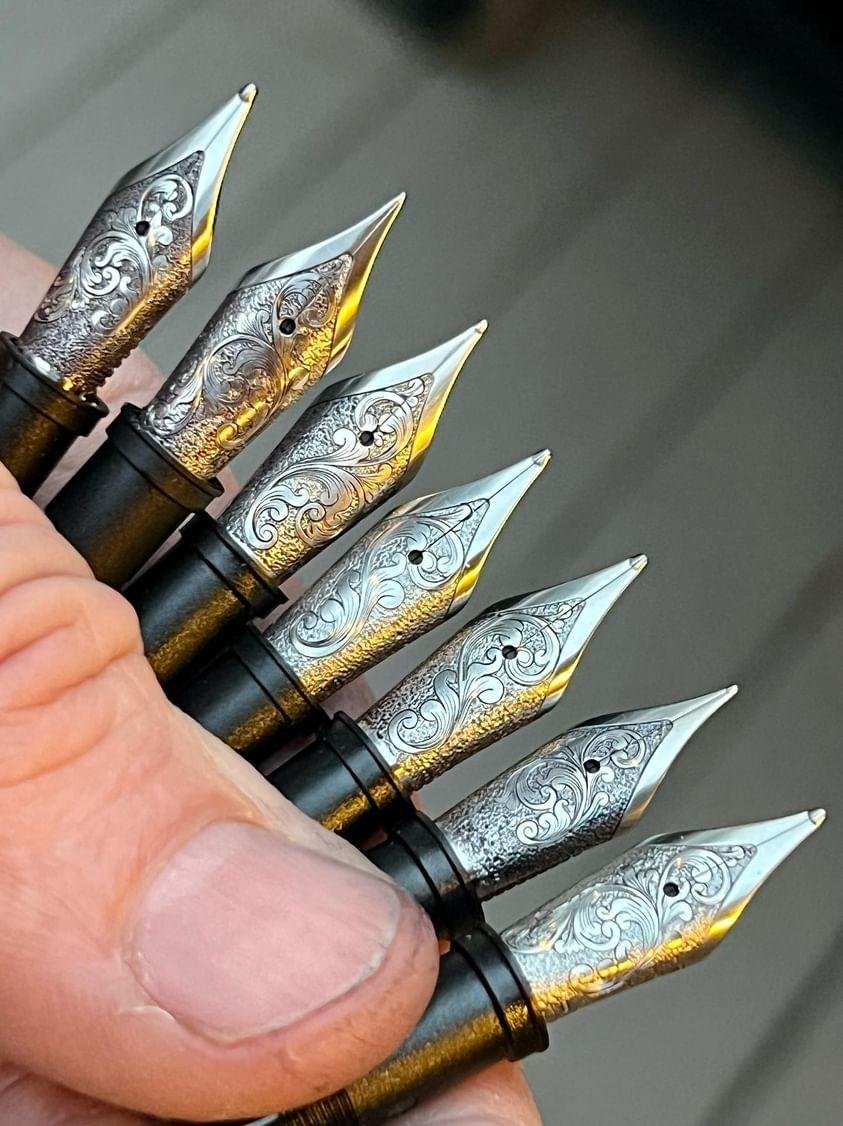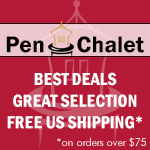(Caroline Foty's first fountain pen was a 1970s Sheaffer No Nonsense that still writes perfectly. Since she discovered pens by independent makers, she wants "one of each, please" and wants to meet all the makers. Maybe you do, too. She lives in Baltimore with pens, cats, and all kinds of fiber arts supplies.)
Sometimes when your friends ask you for things, it changes your life.
Tim Cullen was a police officer in California, with an interest in woodworking but limited space for a shop, when in 2009 a friend asked him for a kit pen. That seemed like the right size item to make in his space. In fulfilling that request, he was bitten by the penmaking bug and never recovered. He was soon making more pens than anything else, and giving them as gifts to friends or as donations to fundraising auctions at his daughter’s school.
Cullen quickly got bored with kit pens – “They’re limited to what can go on two tubes. I wanted to make things that were all my work.” At the end of the first year, he got a metal lathe and began to research how to make threads. After making basic pens for a year, “I was hungry to learn to do everything.” He can make everything necessary to create a pen – even filling systems and feeds, although those are so readily available and inexpensive that he finds the result not worth the time it takes.
Metal work has become a specialty in which Cullen is endlessly interested. He took classes in metalsmithing, hand engraving, casting, and jewelry making to expand the range of options he could make available on pens. “You can incorporate anything you can do into a pen.” He has worked on commission only for nearly ten years, after a pen he shared on Fountain Pen Network received an overwhelmingly positive response, and currently has a waiting list of about two years. The company he established is named after a dog he used to have. That dog is now immortal, and most of his customers are returning for multiple Hooligan pens.
Cullen finds the individualized hand-done processes to be the most satisfying. “The work I do, you could have done a hundred years ago.” He used taps and dies for his threads for several months, but then stopped, and uses internal and external threading tools to make threads by hand on the lathe. This lets him make a pen in whatever size the customer wants, instead of working within the limits of the tap and die sets on hand. The materials of his pens are frequently unusual items supplied by customers. One pen was made from pieces of wood and wrought iron from a textile mill destroyed by fire in Alabama. A pen in work for his mother-in-law honors her love of Hawaii by using koa wood and blue acrylic. Another customer provided leather which he layered onto a metal barrel, and one sent wood from a fire boat.
This design process with customers provides constant variety and artistic inspiration. “I have to think on the fly and be ready for changes, and give regular updates as the pen is made.” This customer-driven process means he doesn’t make a selection of “models” like many other makers do. Sometimes, Cullen will make an experimental pen, by way of research and development, and will offer such pens for sale if they work out. In addition to the wrought iron, he’s worked with meteorite, titanium, copper, stainless steel, nickel silver, and just about everything else you could think of.
Cullen’s preference for metal work does not mean that all his pens are heavy to hold. He has worked on making metal overlays on lighter weight materials, to make the overall pen lighter. His mentor in overlay making was Henry Simpole, who did overlay work for Conway Stewart and a few other major makers.
Does Cullen have a favorite pen he didn’t make? “No! I don’t have time to write with pens!” He has kept two of his own pens. In 2014 he made a limited edition of titanium and kingwood and kept one for himself, and he also made himself a pen in red acrylic (his favorite color) with a #8 nib for signing his authenticity paperwork. A favorite pen he made and didn’t keep was created for a fire chief in Florida, using red ebonite, with a badge engraved in the cap band and hand engraved flames on the clip.
Cullen’s constant quest to find new ways to add to his pens led him to make and engrave nibs. He’s been hand engraving designs into Bock and Jowo nibs for several years, and can make nibs from scratch as well, usually from continuum, which is an alloy of palladium and sterling silver. To improve the accuracy of cutting nibs, he is working with engineer Robert Sanchez (of Rob’s Pen Works) to design a nib slitting fixture instead of cutting them by hand, to avoid mistakes with the expensive materials.
Handmade nib.
This drive to make everything himself does not extend to making materials or casting blanks. “I’d never have time for anything else!” He usually uses solid color materials to set off the metal work that is his signature.
Having that signature is all-important for Cullen. When he began making pens, he was particularly inspired by Paul Rossi, Joe Cali, and David Broadwell. Broadwell advised him to set himself apart, to incorporate things other people aren’t using, to make his work unique. At the same time, he wishes more people were doing metal work, incorporating that art into pens, and he has been mentoring some makers who want to take up metal work, including Nick Pasquale of Pens by Pasquale.
Engraved nibs.
Cullen sees this as a good time for pen makers. His customers are a constant source of inspiration and the push to expand his capabilities; he is about to start a class in repoussé and chasing, two different ways of embossing a design into a thin piece of metal, to have yet another technique for putting metal art into pens as well as into the jewelry he occasionally makes. “I’ve got to keep trying new things, so I can do more of what someone might want.”
Tim Cullen’s work can be seen on Instagram, and on his website Hooligan Georgia.
Enjoy reading The Pen Addict? Then consider becoming a member to receive additional weekly content, giveaways, and discounts in The Pen Addict shop. Plus, you support me and the site directly, for which I am very grateful.
Membership starts at just $5/month, with a discounted annual option available. To find out more about membership click here and join us!

























